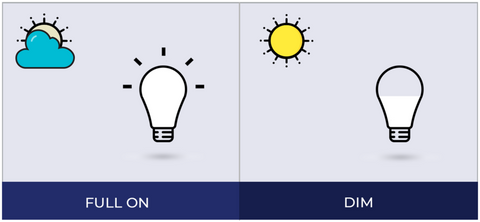Top Six Lighting Control Strategies for energy-efficiency!

Today’s lighting control systems are intelligent, smart, and energy-efficient. They are also capable of creating a personalized lighting experience that suits the user’s needs and mood. The rising demand to meet energy standards and create a visual experience has made lighting controls even more significant. All these can be achieved by gaining fixture control using smarter controls like sensors, schedules, and dimmers.
How does a lighting control system work?
The lighting control system functions on an input and output basis. The input device receives the data, and the controller will decide and act as per the need. Input can be automated or user-controlled with a button press, whereas the output includes adjusting functionalities like RGB, CCT, Intensity, and ON/OFF controls. Lighting controls can be integrated with an individual luminaire or a group of luminaires and create an energy-efficient workspace.
Types of Strategies
The most commonly used strategies are daylight harvesting, task tuning, occupancy sensing, dimming, and scheduling. These strategies improve occupants’ comfort, satisfaction, and productivity, besides reducing labor and electricity costs. It is proven that more than 60% of energy-saving is attained through lighting controls. These strategies can be used for residential, commercial, and industrial applications to reduce energy consumption.
Task Tuning
Task tuning, also called “Institutional Tuning,” is the best way for significant energy savings. The high-end trim feature helps to reduce energy usage by 20%. This strategy involves setting the light intensity to a required level for spaces that won’t require maximum intensity, maintaining the right light level for over-lit areas. Thus, maximum light output can be reduced to suit the occupant’s needs. For example, in a space where maximum light intensity is not required, tune at 70%. When someone else tries to ON the luminaire, the intensity will not go beyond this level. Also, there won’t be a visible difference in the intensity, making it a perfect solution for people who love to work with a minimum light level.

Low-end trim is the lowest light level set to a percentage above zero. If this feature is applied, lights will never go OFF but will dim to the pre-set intensity. For example: In a restroom or corridor, employ a fixture with a minimum dim capacity of 10%. When someone tries to turn OFF the light manually, the luminaire will not turn OFF but dim, which is useful in places where visitors come often.
Daylight Harvesting
Daylight harvesting is the process of adjusting the light intensity in response to the available natural light. This strategy is mandatory to comply with the energy efficiency standards of commercial buildings. Buildings with more windows and daylight can increase ambient light utilization, thereby ensures maximum energy savings.

Occupancy Sensing
Occupancy sensors are an integral part of smart buildings and are the most common lighting control strategy for energy savings.
When someone enters a room, the sensor detects humans’ presence and automatically turns ON lights. When the occupant leaves the room, the lights will be turned OFF or DIM to OFF. This sensor is useful for shared spaces, offices, and workspaces.

Vacancy Sensing
Vacancy sensors automatically turn lights off when an occupant leaves a room, but it doesn’t turn ON lights automatically. Since the lights have to turn ON manually, it can avoid false triggers, and the occupants can turn ON lights only if needed. This strategy has proven reduced energy consumption as the occupants will not turn ON lights when not required, like during daytime.

Scheduling
Scheduling helps to create a personalized lighting experience. With schedules, it is possible to DIM/ON/OFF luminaires at pre-set time slots. It reduces energy consumption considerably, especially in workspaces, which remains empty during overnight and weekends.

Dimming Control
Dimming controls can cut-off energy consumption to a greater extent when compared to ON/OFF controls. Dimmers reduce the brightness and intensity of the luminaries as required, resulting in reduced energy usage. The most widely used dimming technology is the 0-10v analog and DALI dimming system.
In short,
The lighting control strategies such as schedules, occupancy sensing, daylight harvesting, and high-end trim deliver innovative and energy-efficient lighting for indoor, commercial, architectural, and entertainment applications.
Disclaimer: The original version of the blog was published in WiSilica.com